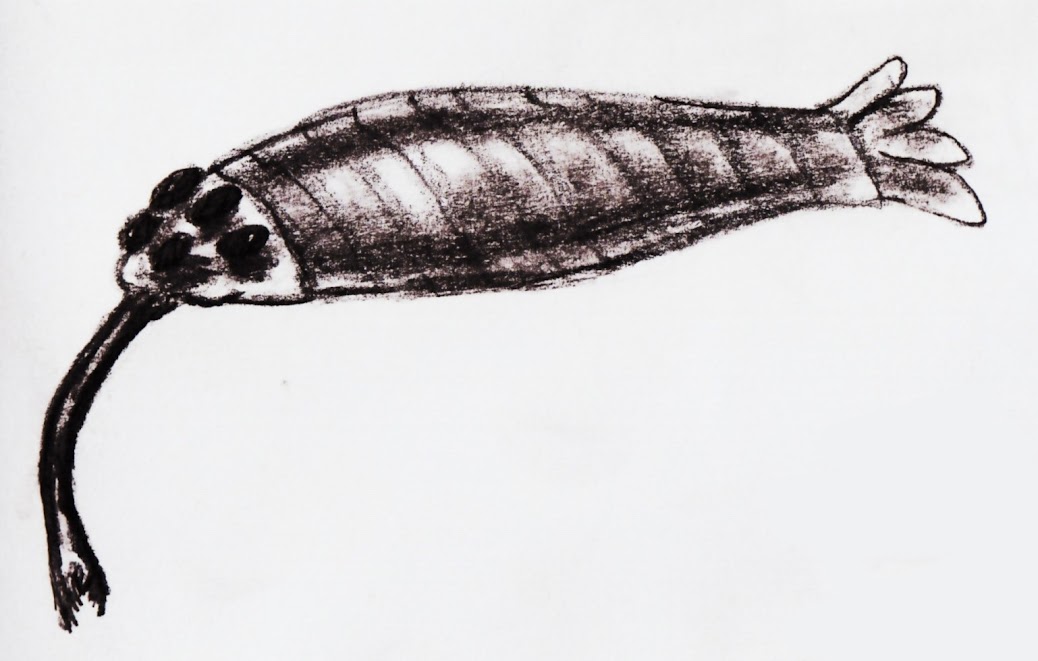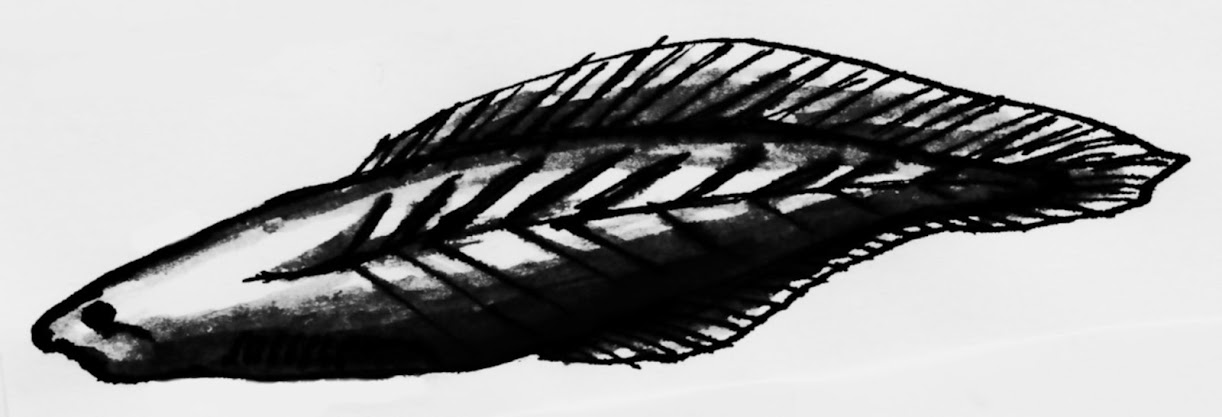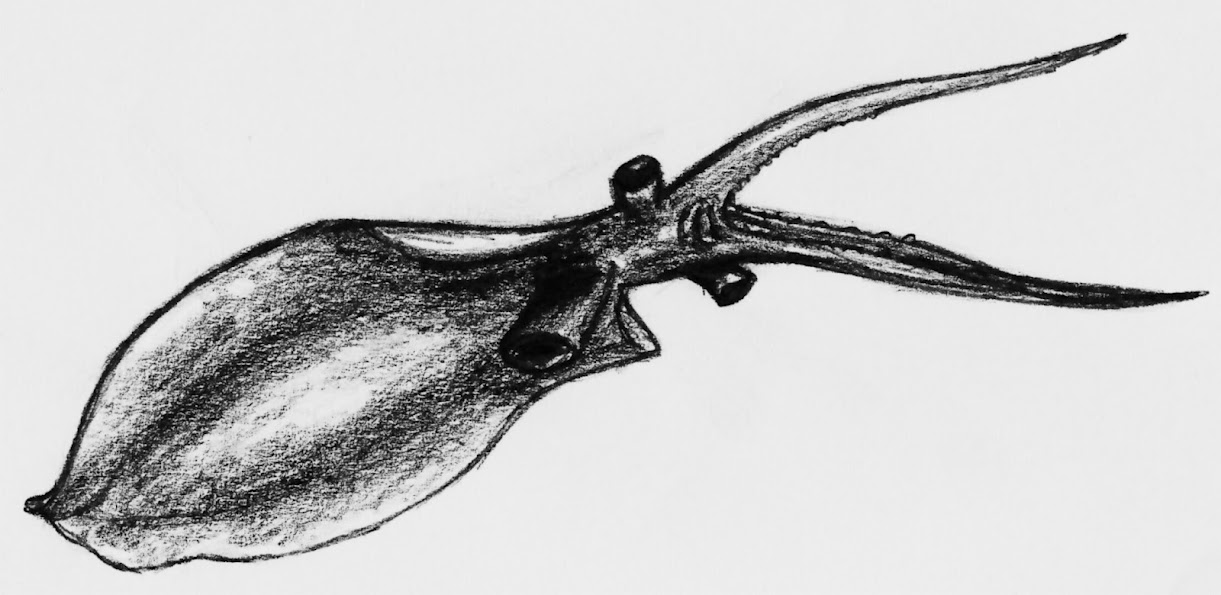Here I am going to give an overview to the history of life on earth.
Precambrian
After the earth, formed 4.6Ga (Ga=Giga+Annus=1 billion years) ago, had cooled down enough for liquid water to exist on its surface, the oceans began to form from the steam of countless ice-asteroids that had hailed down on it. During the late archaic era, roughly 3,5Ga ago, the planet was finally ready to get populated by the earliest lifeforms. Where exactly those came from is still not known; some theories state an extraterrestrial origin of life, others that it evolved in the deep sea. What is certain is that for life to evolve, organic molecules (carbonhydrates) had to be formed and connect to each other to form DNa and the first cells. For a long period of time, simple, unicellular organisms were the only living things on planet earth. Among the closest extant analogies are Cyanobacteria, seen on the fossil record in form of stromatoliths. The simplest true lifeforms on this planet are "Procaryota" (Archaea+Bacteria), characterised by their lack of membraneous organelles or a nucleus. Eukaryota, which have those traits, contain all macroorganisms including ourselfes, plants and fungi, but also a huge array of unicellular organisms, and first appeared about 1.5Ga ago, starting out with animals like Tappania. Life can be divided into the three great domains of Archaeans, Bacteria and Eurcaroytes. It was only by the Tonian period, around 1 Bya, that the first multicellular organisms evolved. There are several lineages that developed such a built as a feature of convergent evolution. Modern examples are greater fungi, plants and Metazoans. Sponges (Porifera, perhaps paraphyletic) are currently considered the most basal extant metazoans. Other early multicellular taxa (reported from the Precambrian) include multicellular algae, cnidarians and various groups of invertebrates commonly referred to as worms, as well as mat-like organisms of uncertain relations such as Dickinsonia, Charnia or Spriggina. The terminal Precambrian Ediacarian period saw the first explosion of large lifeforms. During the end of the Proterozoic the scene was set for the Cambrian radiation, which would bring earths biota onto a new level of complexity and abundance, producing many of the animal phyla that still exist today in astonishing and revolutionary ecosystems.Cambrian


 Among these newly evolved animals were arthropods, molllusks, echinoderms and various other groups. A complicated predator-prey-relationship first evolved during the Cambrian. This was caused by the tremendous amount of new lifeforms and structures, especially among animals, which developed. Worm like early chordates like the well known Pikaia, which had developed a stiff brace (chorda dorsalis), gave rise to small, ancestral vertebrates or craniates like Haikouichthys and Myllokunmingia, which didn't posess fins or jaws, but a neurocranium, pharynx and perhaps even a simple vertebral collumn. Vertebrates should prove to be among the most successful animal lineages, not by sheer numbers, but size and dominance in ecosystems, and soon they radiated.
Successful and long lasting groups of jawless vertebrate, like the Cyclostomata and Conodontia, commonly known as "Agnatha", all must have branched off during the Cambrian period.
Basal members of the panarthropod taxon, today mainly represented by arthropods and onychophorans, were the roamers of the Cambrian sea, occupying top-predator niches where they occurred, reaching the largest body sizes of all the cambrian fauna.
Among the largest were Anomalocaridids, perhaps close relatives of arthropods, which could exceed 1m in lenght. Animals like Anomalocaris, Laggania or the bizarre Opabinia filled various predatory niches. All those predators were apparently good swimmers, using fin-like lobes along their flanks to propell themselves through the waters.
But there were many ground-dwelling forms of such weird experiments of nature as well, like the strange Hallucinogenia. It must be noted that of many organisms from these first diversifications of life we know extremely little, often being unable to classify them onto the tree of life. They remain enigmatic and often barely understood.
Among these newly evolved animals were arthropods, molllusks, echinoderms and various other groups. A complicated predator-prey-relationship first evolved during the Cambrian. This was caused by the tremendous amount of new lifeforms and structures, especially among animals, which developed. Worm like early chordates like the well known Pikaia, which had developed a stiff brace (chorda dorsalis), gave rise to small, ancestral vertebrates or craniates like Haikouichthys and Myllokunmingia, which didn't posess fins or jaws, but a neurocranium, pharynx and perhaps even a simple vertebral collumn. Vertebrates should prove to be among the most successful animal lineages, not by sheer numbers, but size and dominance in ecosystems, and soon they radiated.
Successful and long lasting groups of jawless vertebrate, like the Cyclostomata and Conodontia, commonly known as "Agnatha", all must have branched off during the Cambrian period.
Basal members of the panarthropod taxon, today mainly represented by arthropods and onychophorans, were the roamers of the Cambrian sea, occupying top-predator niches where they occurred, reaching the largest body sizes of all the cambrian fauna.
Among the largest were Anomalocaridids, perhaps close relatives of arthropods, which could exceed 1m in lenght. Animals like Anomalocaris, Laggania or the bizarre Opabinia filled various predatory niches. All those predators were apparently good swimmers, using fin-like lobes along their flanks to propell themselves through the waters.
But there were many ground-dwelling forms of such weird experiments of nature as well, like the strange Hallucinogenia. It must be noted that of many organisms from these first diversifications of life we know extremely little, often being unable to classify them onto the tree of life. They remain enigmatic and often barely understood.
Simplyfied Taxonomy of Panarthropoda |--Panarthropoda `---Arthropoda |--Lobopodia |--Tardigrata |--Onychophora
 The first true arthropods also emerged during this period. Among them were trilobites and animals resembling crustaceans, two families that would prove tremendously successful during the periods to follow.
Mollusks had probably developed as free swimming, slug-like animals, comparable to some extant sea slugs in shape. While some of them developed a shell and proceeded to a ground-dwelling lifestyle, others gave rise to the first cephalopods. The earliest known form is Nectocaris, an animal with only two arms and a soft body. Many later forms developed a straight or coiled shell, others forming a cuttlebone like it can be seen in many modern cephalopods.
The first true arthropods also emerged during this period. Among them were trilobites and animals resembling crustaceans, two families that would prove tremendously successful during the periods to follow.
Mollusks had probably developed as free swimming, slug-like animals, comparable to some extant sea slugs in shape. While some of them developed a shell and proceeded to a ground-dwelling lifestyle, others gave rise to the first cephalopods. The earliest known form is Nectocaris, an animal with only two arms and a soft body. Many later forms developed a straight or coiled shell, others forming a cuttlebone like it can be seen in many modern cephalopods.
Simplyfied Taxonomy of Mollusca |--Mollusca `---Bivalvia |--Monoplacophora |--Cephalopoda |--Scaphopoda |--GastropodaThe first Echinoderms to appear were crinoids dating back to the early Cambrian.
Ordovician
 By this period, the arthropods had diversified and developed into top predators. Especially eurypterids, basal members of the Chelicerata clade that includes extant spiders and scorpions, were very successful and dominant.
By this period, the arthropods had diversified and developed into top predators. Especially eurypterids, basal members of the Chelicerata clade that includes extant spiders and scorpions, were very successful and dominant.
Simplyfied Taxonomy of Arthropoda |--Arthropoda `---Trilobita |--Crustacea |--Chelicerata |--TracheataThe Ordovician was the only period in which cephalopods took on the role of apex predators. Nautiloids with straight shells, the orthocerida, brought forth some huge genera, the giant, up to 12m long Cameroceras being the most well-known. Other forms developed coiled shells, and several intermediate forms are reported. Their ancestors remain surprisingly unchanged up to present day.
Simplyfied Taxonomy of Cephalopoda |--Cephalopoda `---Nautiloidea |--Ammonitoidea |--Bellemnitoidea |--Decabrachia |--OctopodaWhile larger animals were likely swimming in open waters, the sea floor was populated by trilobites, which thrived during this period. For the very first time coral reefs composed mainly of rugosan corals emerged, representing a habitat for various new lifeforms. Early vertebrates had diversified and now came in many different forms and shapes of small swimmers, tough they were harmless suction feeders due to their lack of jaws. Now many of the rather well known so called "jawless fishes" evolved, including animals like Arandaspis, Astraspis and Sacambaspis. Groups like Anaspida, Osteostraci and Heterostraci likely all date back to this period.
Simplyfied Taxonomy of Vertebrata |--Vertebrata `---Cyclostomata |--Conodonta |--"Agnatha"* |--Gnathostomata*(various groups, at best paraphyletic. Includes Astraspida, Arandaspida, Ostostraci, Galeaspida, Heterostraci etc.) The following is a more detailed cladogram of vertebrate phylogenetics, following one of the numerous hypotheses about this subject.
Cladogram: Vertebrata
During this period, the first organisms populated the landmasses, that until now were nothing but vast deserts hostile to life. Among them were simple mosses that probably evolved from algae that, growing on cliffs, were partially exposed to the air and adapted to become independend from the ocean. These small, unimpressive plants laid the foundation of every other terrestrial of the future. At the end of the Ordovician period a mass extinction caused by global cooling and the destruction of the sensible marine ecosystems ended the era of huge nautiloids, jawless fish and the dominance of trilobites that were more and more replaced by the now emerging Gnathostomates and radiating Eurypterids.
Silurian
At the beginning of this period Eurypterids had diversified and now took over the top of the food chain. Some forms reached a lenght exceeding 2m, like the massive Pterygotus. Unlike their Ordovician ancestors, they hardly had any competition, save for the slowly diversifying jaw-bearing Vertebrates. Some adapted for a live on the seafloor, others remained small, fast swimmers. Vertebrates started to evolve jaws from gill arches during the earliest Silurian or the late Ordovician, enabling them to take over predator niches for the very first time. Two of the earliest and basalmost successful groups of gnathostomes, the now extinct Acanthodians and Placoderms, radiated in the Silurian oceans.Further Information will be added soon!